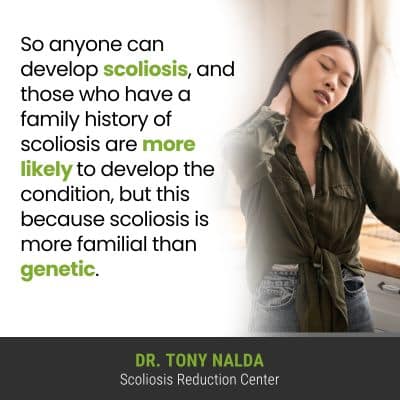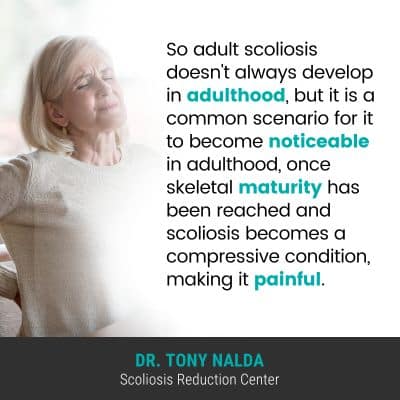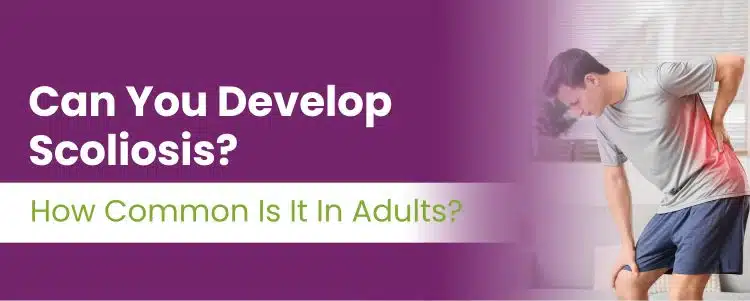Scoliosis can affect babies born with the condition, infants, juveniles, and adolescents, and is diagnosed as adult scoliosis once skeletal maturity has been reached. The estimated rate of scoliosis in adolescents is between 2 and 4 percent, while the rate in adults is estimated at between 12 and 20 percent.
Scoliosis is a spinal condition that affects all ages. It’s more commonly diagnosed in children, but the actual rate of scoliosis increases with age; this is due to natural age-related spinal degeneration. Adults are most often affected by idiopathic scoliosis and degenerative scoliosis.
Anyone can develop scoliosis, but before getting to the specifics of adult scoliosis, let’s start with how it develops.
How Does Scoliosis Develop?
Scoliosis involves the development of an unnatural sideways-bending and rotating spinal curve, so a scoliotic spine doesn’t just bend unnaturally to the side, it also twists, and as a progressive condition, once scoliosis has developed, its nature is to get worse over time.
As scoliosis develops, uneven forces are being introduced to the body, and those uneven forces cause a number of effects that can vary from person to person.
In most cases of scoliosis, we don’t know what triggers their initial onset, but we do know what triggers them to progress: growth.
Idiopathic scoliosis isn’t associated with a single-known cause, and accounts for approximately 80-percent of known diagnosed cases, and idiopathic scoliosis is the most common condition type to affect all ages, including adults.
The remaining 20 percent of known cases have known causes, and these types are considered atypical and pose treatment challenges: neuromuscular scoliosis, congenital scoliosis, and degenerative scoliosis.

Cases of neuromuscular scoliosis, for example, are caused by a larger neuromuscular condition such as cerebral palsy, spina bifida, or muscular dystrophy, so the larger neuromuscular condition has to be the focus of treatment.
So the development of idiopathic scoliosis isn’t fully understood, and the condition is thought to be multifactorial, meaning caused by several factors that can differ from person to person.
So anyone can develop scoliosis, and those who have a family history of scoliosis are more likely to develop the condition, but this is because scoliosis is more familial than genetic.
Scoliosis is Familial
It’s difficult for patients recently diagnosed with idiopathic scoliosis to hear that we don’t know why it develops, and while a lot of research has been done on the topic of whether idiopathic scoliosis is genetic, the general consensus is that the condition is more familial than genetic.
Having a family history of scoliosis does increase the likelihood of having another family member developing scoliosis, but despite the years of research and studies dedicated to isolating a specific gene, or genetic mutation, that can account for the condition’s development, it has yet to be identified.
What has been identified, however, are familial factors that can contribute to the condition’s multifactorial nature and development; remember, families share a lot more than just their genes.
Common familial factors included similar body types, BMI, lifestyle, diet, activity levels, responses to stress, socioeconomic factors, posture, and responses to stress.
Given the multifactorial nature of idiopathic scoliosis, it’s thought that a combination of certain factors, which can vary from person to person, can contribute to the condition’s development, and we know that growth is what triggers it to progress, which is why childhood scoliosis needs to be taken seriously.
Now, let’s address the differences in adult scoliosis development and progression.
Adult Scoliosis
While the most common type of scoliosis is adolescent idiopathic scoliosis, diagnosed between the ages of 10 and 18, and this age group is the most at risk for rapid-phase progression due to puberty, adults also face progression.
While the progressive trigger of growth is removed once skeletal maturity has been reached, adults still progress, particularly once natural age-related spinal degeneration comes into play.
Idiopathic Scoliosis in Adults
The two most common types of scoliosis to affect adults are idiopathic scoliosis and degenerative scoliosis.
Cases of idiopathic scoliosis in adults actually develop years before they are diagnosed; these are cases of adolescents who developed adolescent idiopathic scoliosis, but were unaware, so didn’t receive a diagnosis or treatment.
Once skeletal maturity has been reached, scoliosis becomes a compressive condition, but while the spine is still growing, the condition isn’t known as overly painful; this is a key difference between childhood and adult scoliosis.
As a child grows, the spine experiences a constant lengthening motion that counteracts the compressive force of the unnatural spinal curve, and it’s compression of the spine and its surrounding muscles and nerves that causes the majority of condition-related pain.

So adult scoliosis doesn’t always develop in adulthood, but it is a common scenario for it to become noticeable in adulthood, once skeletal maturity has been reached and scoliosis becomes a compressive condition, making it painful.
Pain is the main effect that brings adults in to see me for a diagnosis and treatment, and in children, muscle pain can be present, but the main effect involves postural changes (uneven shoulders, one shoulder blade sitting higher than the other, the development of a rib cage arch, an uneven waist) caused by how the condition disrupts the body’s overall symmetry.
Scoliosis pain for adults can involve muscle pain, back pain, and nerve pain that radiates into the extremities (arm and leg pain) due to nerve compression.
The actual rate of scoliosis increases in aging adults, and this is due to spinal structures deteriorating over time.
Degenerative Scoliosis
After idiopathic scoliosis, degenerative scoliosis is the next most-common condition type to affect adults, and it develops due to natural age-related spinal degeneration and the cumulative effect of certain lifestyle factors.
There is a certain amount of spinal degeneration to be expected with age, but certain lifestyle factors can shape its level and rate: carrying excess weight, leading a sedentary lifestyle, chronic poor posture, excessive consumption of alcohol and/or smoking, and repeatedly lifting heavy objects incorrectly.
Carrying excess weight puts extra pressure on the individual structures of the spine, and leading a sedentary lifestyle is contrary to the spine’s movement-based design.
Chronic bad posture can, over time, introduce adverse spinal tension and uneven wear and tear on the spine, and repeatedly lifting heavy objects incorrectly, with the back instead of the lower body can strain the spine and make it vulnerable to injury.
Excessive alcohol consumption and/or smoking contributes to disc desiccation, and when it comes to natural age-related spinal degeneration, it’s most often the spine’s intervertebral discs that are the first structures to start to deteriorate.
The spine’s intervertebral discs are key to its health and function; a disc sits between adjacent vertebrae providing cushioning so friction and degeneration don’t occur during activity, they act as the spine’s shock absorbers, give the spine structure (adjacent vertebrae attach to the disc in between), and they combine forces to facilitate spinal flexibility.
Once a disc starts to degenerate, it tends to lose fluid and change shape, and this disrupts the position of adjacent vertebrae attached to the deteriorating disc in between, and this can cause degenerative scoliosis to develop because the spine’s degeneration disrupts its ability to maintain the spine’s natural curves and alignment.
So while studies on scoliosis prevalence in adolescents show an estimated rate of between 2 and 4 percent, studies on the prevalence of scoliosis is healthy adults over the age of 60 show rates as high as 68 percent.
Conclusion
People of all ages can develop scoliosis, and while children are more frequently diagnosed with the condition, the actual rate of scoliosis increases among the aging population due to the development of degenerative scoliosis, and cases of adolescent idiopathic scoliosis that were undiagnosed and untreated during adolescence.
As we age, the spine, like the rest of the body, is subject to degenerative changes, and lifestyle factors help shape a person’s level and rate of spinal deterioration.
If one or more intervertebral discs have become desiccated due to degeneration, they tend to lose height, change shape, and disrupt the positioning of adjacent vertebrae; degenerative disc disease is a contributing factor in the development of a number of spinal conditions/issues, degenerative scoliosis included.
Here at the Scoliosis Reduction Center®, patients of all ages benefit from a proactive conservative treatment approach that combines multiple scoliosis-specific treatment disciplines to impact conditions on every level.
Through chiropractic care, when treating adult scoliosis, the goal is to achieve a curvature reduction, but reducing it back to where it was prior to becoming painful is the goal, along with increasing spinal support and stabilization; age-related spinal degeneration can increase progression as the spine becomes more unstable and unbalanced.
While there are never treatment guarantees, scoliosis diagnosed early and responded to proactively is associated with treatment success, and scoliosis treatment that’s not started until it becomes severe is a traditional treatment response that funnels patients towards spinal fusion surgery.
The potential risks, side effects, and complications of spinal surgery should be considered carefully, and the risk factors only increase with age and with each additional surgery.
People with scoliosis need to understand that as a progressive spinal condition, the best time to start scoliosis treatment is always now; when it comes to managing symptoms of scoliosis, most patients benefit from a nonsurgical treatment plan that includes chiropractic adjustments, physical therapy to increase the strength of the abdominal muscles for better spinal support, a back brace to relieve pain short-term, and helps adult patients avoid invasive surgical procedures.




